If you can’t measure it, you can’t improve it. In the world of PR, it can be easy to completely forget why you’re doing public relations in the first place. Measuring PR campaigns helps you work out your progress and define what you could be doing more (or less of) to succeed.
As an agency or a PR professional, you can use PR campaign results to earn your seat at the table. With the right success measurements, you can refine communication strategies and show exactly how much your PR effort contributes to overall brand success.
By measuring PR campaign effectiveness, you can use data-driven insights to create even better campaigns and show clients proof of your hard work and its results.
Today, we’re going to show you how to measure public relations success — we’ll walk you through the processes, key PR success metrics, and take you step by step so you can become a pro at measuring PR success.
If you’re short on time and need to track the performance of your PR campaign — give Prowly a go. Take advantage of the 7-day trial and access media monitoring, the media database and PR reports — all in one! See if it’s a match for your needs.
How to measure PR campaign performance
Public relations is all about media and how your brand (or a client’s brand) is represented in various media outlets. On websites, social media, television, in newspapers. The main issue is that keeping track of who mentions you, where, and how can get very tiring, very fast.
That is where media monitoring comes in. These tools are specifically made to track when someone mentions you across different platforms. With a media monitoring tool, you can find out:
- who mentioned you
- where the mention came from (the web, forums, social media, etc.)
- what the sentiment of the mention is (positive, neutral or negative)
All of this data helps you to measure public relations effectiveness and determine if you’re going in the right direction or not.
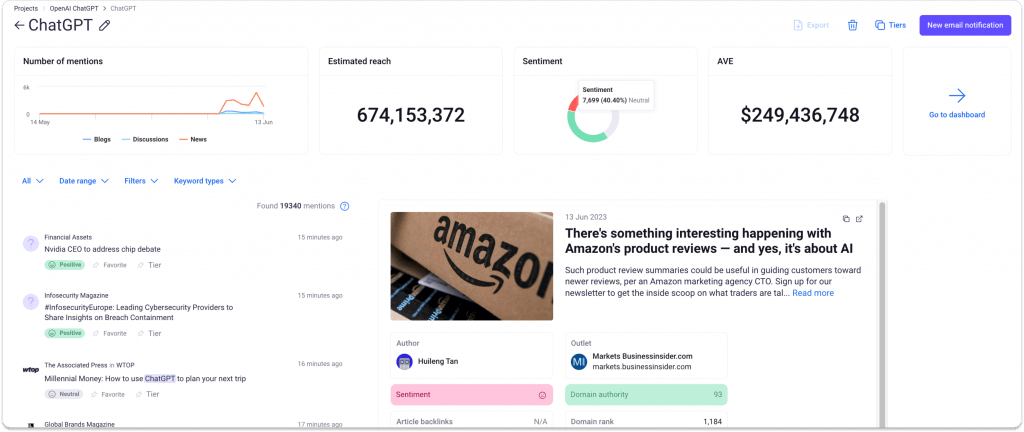
How to measure campaign performance with Prowly
For example, Prowly’s media monitoring tool lets you get started in mere minutes.
First, set up a project and choose the terms you want to track. This can be just about anything, but usually, it’s one or more of these:
- Your business name
- Relevant hashtags
- Campaign-specific terms
- Terms relevant in your industry
- Competitor brand names
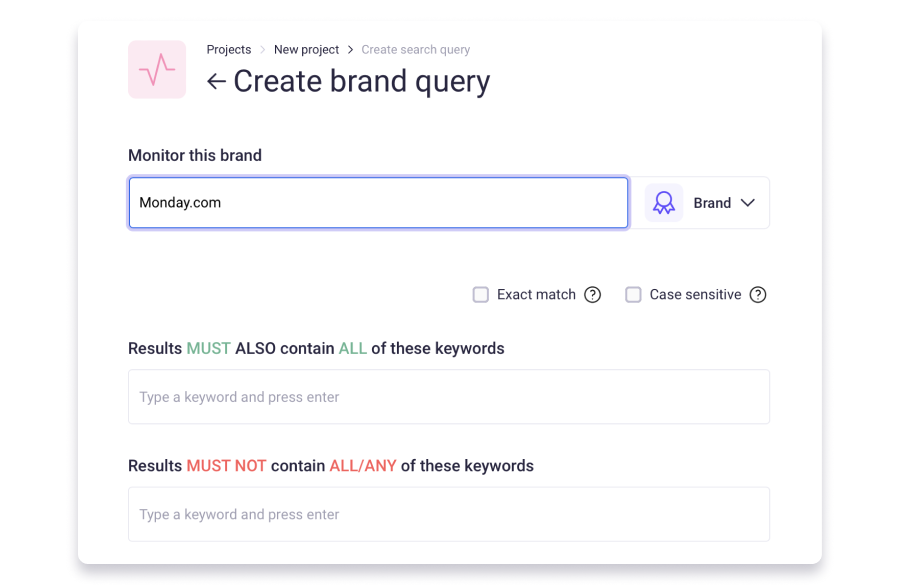
At this point, you’ll get all the possible media mentions for these terms. If you have a large brand and following, you’ll also get a lot of irrelevant results, so it’s time to do some filtering. So, for each campaign, you can add the following filters:
- Keyword combination and context
- The topic and website of each mention (over 1,000 combinations possible in Prowly)
- The estimated mention reach
- The region and language of the mention
- And many other filters
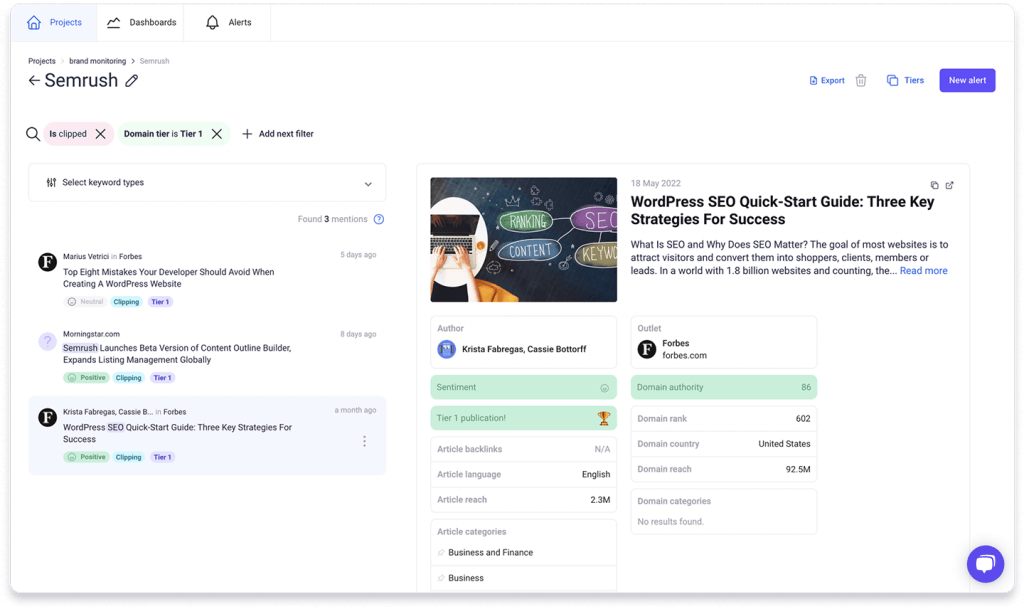
At this point, the mentions that you see will be much more useful as you’ll get only the most relevant results.
You could check the Prowly dashboard to see the performance of your mentions in real-time. But no one really has time for that, right? That’s why you can get emails direct to your inbox with digests and alerts.
Simply head to your dashboard to set up custom alerts. You can get recurring summaries for your top mentions, with relevant data such as sentiment and sources. And if an emergency arises, there is nothing to worry about, as you’ll know about it right away.

You can set up spike alerts for situations when your tracked terms start getting a lot of mentions in a short time period, especially in a negative context. These email notifications allow you to get all the relevant updates but also to get immediately notified if things start going wrong.
And if you want a birds’ eye view of things, you can create fully custom dashboards tailored to your needs. Add your own metrics, filters and chart types to display only the most relevant results. Create a dashboard for your PR team, another one for the CMO, and something entirely different for the company management.
The best part is — you can start Media Monitoring for free.
Step 1: Planning and goals
A media monitoring tool can set you back thousands of dollars per year. This is why it’s important to take care of your planning and establish goals first. Ask yourself the following questions:
- What kind of PR campaigns are you planning to run?
- What does success entail in these campaigns?
- Do you want to measure brand awareness, sentiment, or something entirely different?
Depending on what the ultimate goal of your PR campaign is, you can choose the appropriate metrics.
For example, in Prowly, you can track the following public relations metrics:
- number of mentions
- estimated reach
- domain reach
- AVE
- top mentions
- share of voice
- sentiment
- mention backlinks
- domain rank
- domain authority score
- custom metrics
- engagement type
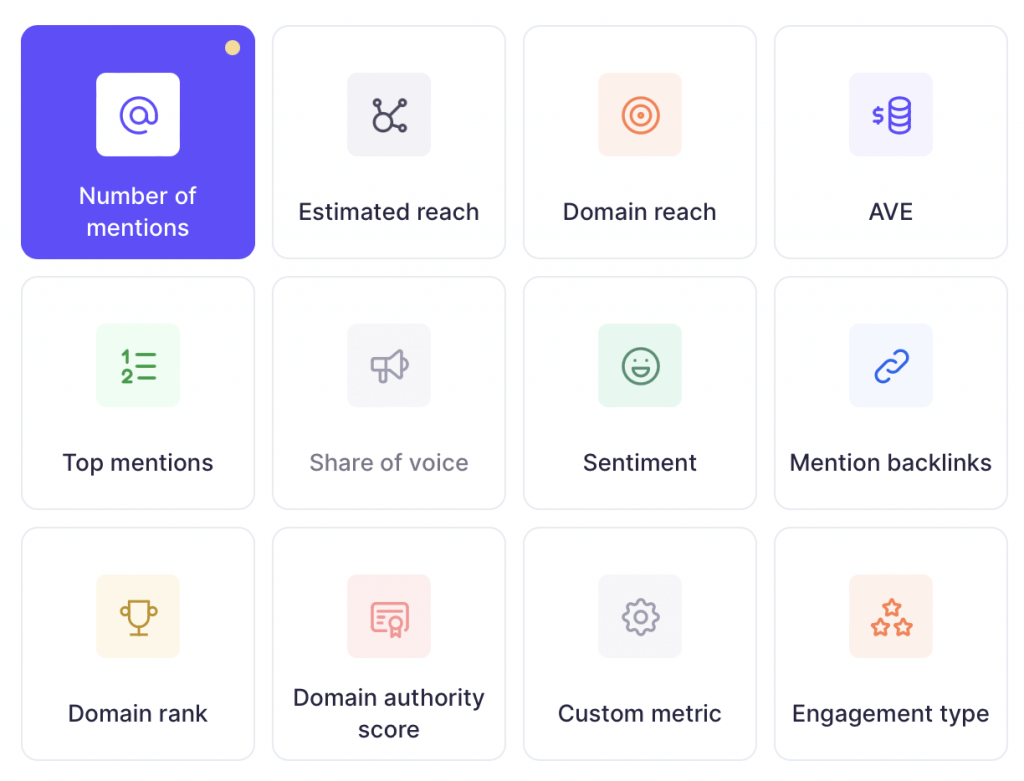
For example, if your main goal is to measure sentiment after a new product launch, you can set up Prowly to perform campaign measurement for this goal alone. This is how we suggest you arrange the process to look:
- Test your brand sentiment often to have a solid basis for comparison
- Combine data science with a human touch (and never rely on tools alone for sentiment analysis)
- Benchmark your results against competitors (by tracking both yours and their brand sentiment and making comparisons over time)
You can choose your preferred channels, set the term(s) you want to track, and watch as the mentions roll in, each with its own sentiment score.
You can also learn all about using social monitoring for PR from The Complete Social Media Listening Guide for Public Relations.
Step 2: Examples of PR metrics to track
If you’re new to PR and wondering how to effectively track the results of your campaigns, we can help out. The main distinction you need to make is between vanity and quality metrics.
💡Vanity metrics don’t tell you much about the actual performance, but they look great on paper.
Before being able to choose the right kind of quality metrics, you need to know what vanity metrics are first.
Examples of vanity metrics
◾️ AVE (Advertising Value Equivalent)
This is the flagship example of a vanity public relations metric. The concept of Advertising Value Equivalency (AVE) involves estimating the value of a PR mention by comparing it to the cost of a similar advertisement.
To illustrate, if your PR campaign yields a quarter-page article in a printed magazine, you would assign the PR mention a value equivalent to the cost of that ad space.
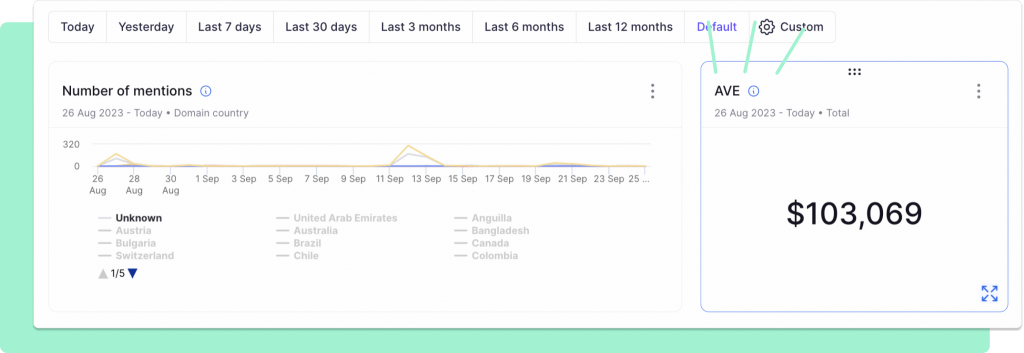
But here is the problem: the outdated AVE PR metric is no longer effective for modern PR. Originally developed in the 1940s(!), it fails to fully capture the dynamics of today’s digital landscape.
→ Discover the complete article on AVE in PR to gain valuable insights and recommendations on effectively utilizing the AVE metric. Learn when to use it and when to consider alternative approaches.
◾️UVPM (Unique Visitors per Month)
This is a metric used to measure the number of individuals who have accessed a specific website within a given month. You can find it for a website when reviewing monthly website traffic. It’s also called Domain Reach.

It’s important to note that the interpretation of UVPM varies between PR and sales/marketing teams, and it is rather generic.
→ If you’re wondering how to calculate UVPM, and what to use as an alternative, check out “What is UVPM in PR? (UVPM metric alternatives).”
You might be wondering why vanity metrics are still being used then. The reasons are many:
- the C-suite understands these metrics well
- clients expect you to report on these metrics based on previous experience
- they’re easy to generate in various PR tools
- the numbers look impressive on paper and give a feeling of accomplishment and a large ROI
Now, here are some more practical, hands-on PR metrics that will better reflect the results of your PR campaigns.
Examples of quality metrics
Unlike vanity metrics, quality metrics give you tangible results. Using these metrics, you can fairly accurately determine your campaign performance.
To improve brand visibility:
Unlike AVE and UVPM, there are PR metrics that accurately portray the effects of a PR campaign on your overall brand visibility. Here are our top choices:
◾️ SoV (Share of Voice)
If you want to see how your brand stacks up against others in terms of visibility, Share of Voice is the metric to go for. Use it to track the organic, unpaid mentions of your brand across the web.
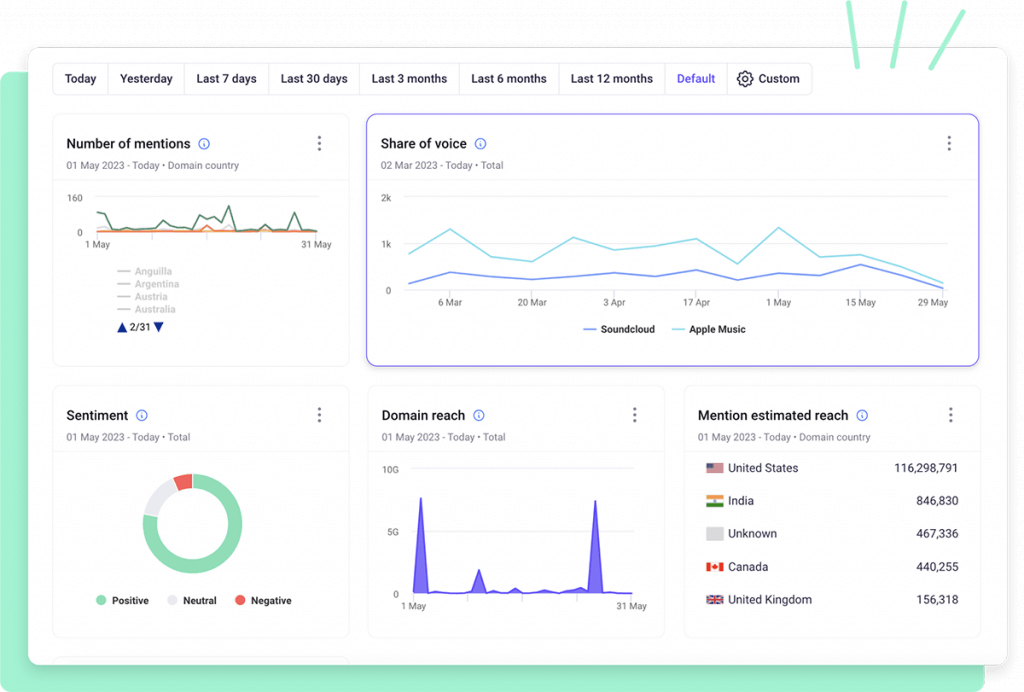
To track mentions in relevant media outlets:
Media mentions are the backbone of successful PR campaigns. By using specialist media monitoring tools such as Prowly, you can get real-time alerts about mentions in relevant media outlets across the internet.
From blogs, forums, review websites and social media platforms, you can track where and how your target audience is talking about your brand. If it’s online and public, we can dig it up and ping you.
◾️ Media tiers
A top metric you can use is media tiers — which track your mentions in designated media tiers, as the name suggests. For example, you can use this PR measurement to determine if your brand gets enough mentions on TikTok — if that’s where your audience is. It gives you a precise answer to the question — am I being mentioned on the right platforms?
In Prowly, you can set advanced filters that will break down your mentions across platforms. With a single glance, you can see your most successful channels and the number of mentions coming from each.
◾️ Top mentions
Another metric is top mentions. For you, “top” as a form of PR measurement is unique, so you can set up what “top” means in Prowly. For example, it can be a list of top mentions in articles in the advertising industry, sorted by the domain rating of the website which mentions you.
To improve SEO performance:
SEO performance can be measured in many ways and it can have an immediate effect on your PR efforts. With PR tools such as Prowly, you can also monitor your progress on the SEO front through a number of relevant metrics.
◾️ The number of backlinks
PR measurement can include SEO performance. For example, you can track the number of incoming backlinks to your website with Prowly. As each new mention comes in, you can see it in your Prowly dashboard, and the graph will show your overall number of backlinks over time.
This powerful feature costs hundreds of dollars per month in dedicated SEO tools. In Prowly, you get it as a free add-on to our media monitoring suite.
◾️ Domain authority
You can also track the domain authority of the websites where your mentions and backlinks are coming from. Domain authority is a metric based on machine learning that tells you how “strong” a website is in terms of SEO performance. The bigger the number is (on a scale from 0 to 99), the better the domain and the more valuable the backlink.
This helps people with little to no SEO knowledge understand how your PR efforts are contributing to SEO results as well.
How to measure PR efforts effectively
To get started with public relations measurement, you’re going to need a toolset to cover all operations. With Prowly, you can do it all — find relevant media contacts, create and send out press releases, track your brand mentions, create PR reports, and much, much more.
Having said that, here is our suggestion for easy and affordable measurement in PR.
Media monitoring
Media Monitoring & Social media monitoring is the process of tracking mentions and discussions in real-time. The main aim of media monitoring is to focus on short-term results and see campaign effectiveness sooner rather than later.
You can also use it to track press hits and social media mentions with advanced filters and AI. This way, you can save your attention for only to the mentions that really move the needle.
Prowly’s AI analyzes the context, sentiment, and more than 15 other properties of each press mention. Leverage this information to establish tailored filters that allow you to view only the mentions that matter most to you.
Examples of filters:
- Keyword combinations & context
- Topic of each mention and website (1000+ available)
- Estimated mention reach
- Region and language
- And many more
You can set up alerts for your most important keywords and choose how to receive them. If time is of the essence, you can get notified instantly. Alternatively, you can set up email alerts on a daily, weekly, or monthly basis.
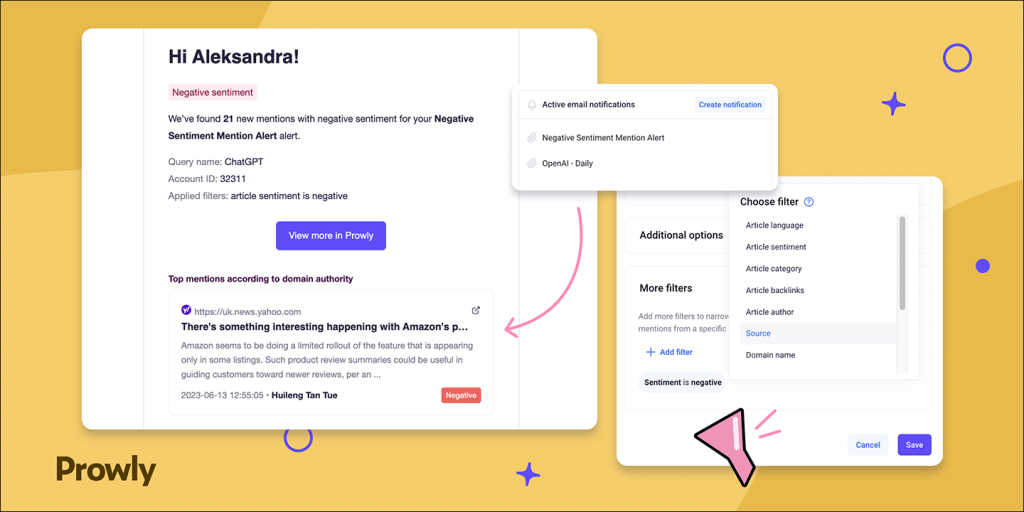
Another major advantage of media monitoring is that you can spot and prevent crises before they arise. In case of a major problem with your brand, media monitoring tools such as Prowly let you know when there is an increased number of mentions with a negative sentiment. You can then take adequate PR measures and nip the blooming crisis in the bud.
Social listening
While seemingly similar, social media monitoring and social media listening are two distinct terms.
Social listening is the broader discipline of tracking mentions beyond quantitative insights. Social listening also includes qualitative metrics, such as the sentiment attached to the mentions, as well as overall social trends.
While social media monitoring merely collects the various mentions of your brand, listening is used to understand the context behind the mentions and get to the overall perception of your brand.
With Prowly’s social listening, your PR team can demonstrate the value of their work. Besides quantitative metrics, you can use sentiment analysis to showcase the impact of your team’s (or agency’s) work on overall business performance.
All of your data from the social monitoring section is added to social listening, so there is no need to do any manual work at all.
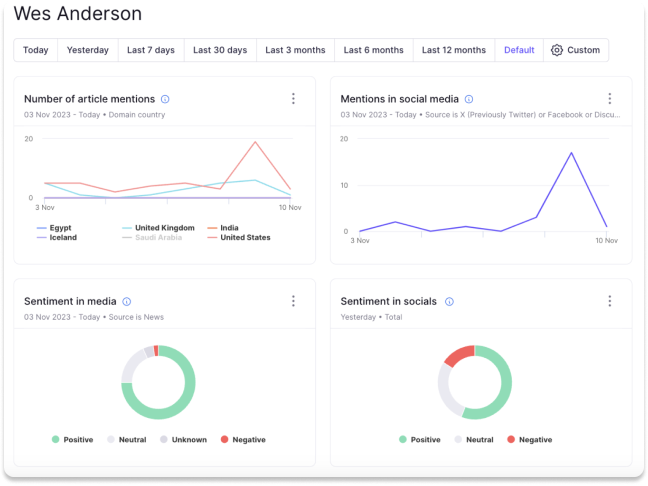
PR reports
PR reports are the best way to communicate progress. No matter who reads the reports, creating them and adding relevant PR measurement metrics should be effortless. Ideally, the tool you use for social monitoring and listening should plug into your reports automatically. That way, you can create reports in minutes rather than needing to work on them manually for hours.
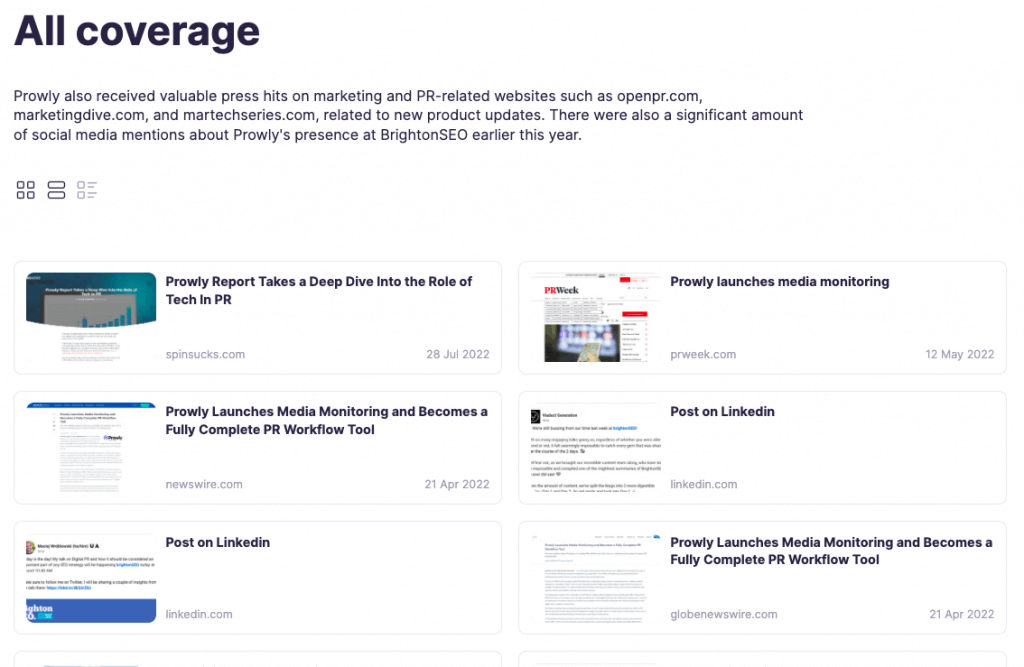
💡 As we said above, PR reports are an amazing tool for understanding your PR results when they are done right. The best PR reports are catered to a specific audience: a PR manager, VP of marketing, CEO, VP of finance, or someone else. With Prowly, you can create customized reports with the right metrics for just the right target audience.
Conclusion
Now you know how to measure PR effectiveness and which metrics to choose to accurately show the results of your campaigns. Even if you have the most sophisticated, expensive PR software in the world, it won’t matter much if you don’t choose the right PR metrics.
With Prowly, you can rest assured that all of the hard work has already been done. Just sign up for your free trial, choose the pre-set metrics most relevant to your campaign, and start measuring your PR efforts today.

